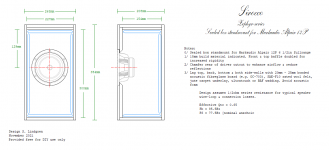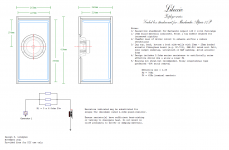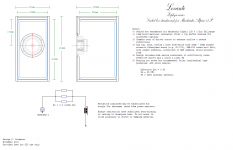Pleasure.
Of a slightly different variety, yes. New range In the works. 😉
More 12p options, exciting, thank you Scott!
Glad to see a 30 L standmount (Juliet, Puck) using the 12.2p since I was initially interested in such an enclosure. Thanks Scott. Has anyone built this enclosure? and your thoughts?
I went through the posts and I believe Dave has built and likes the Juliet. Could you tell us what you liked and disliked about this enclosure?
I went through the posts and I believe Dave has built and likes the Juliet. Could you tell us what you liked and disliked about this enclosure?
Unlikely, I only designed them a couple of months ago, and IIRC I hadn't posted them until the above. Dave will be referring to one of his own resistively vented designs -he's alergic to the majority of vented boxes, QW variations excepted. 😉
Scott,
Just curious to know why only one of the sides has damping.
You recommend bracing for the Juliet but how would you brace it since there already is a "divider"? Would a vertical brace like the holey work? How about a window brace?
BTW, what are your thoughts on lining the inside with bitumen to reduce resonance?
Thanks
Just curious to know why only one of the sides has damping.
You recommend bracing for the Juliet but how would you brace it since there already is a "divider"? Would a vertical brace like the holey work? How about a window brace?
BTW, what are your thoughts on lining the inside with bitumen to reduce resonance?
Thanks
For the damping, that's all that's required. Bracing ideally is a holey brace type. Window-braces are better than nothing, but not as effective. Bitumen does not reduce resonance -it just lowers the Fs of the panel it's attached to, which can be counter-productive. Ideally, like Dave, GM & some others, for bass enclosures I prefer high-rigidity panels, well-braced to raise the panel Fs above any point it's likely to be excited by the box. Adding bitumen can just drop that back down into a problematic area again, so in general I prefer to avoid it in significant quantities.
Yes, the same kind of vertical holey driver brace seen in many of our “official” drawings.
dave
dave
Bitumen are good for a mid or top or a bookshelf that doesn't go too low i think. I used bitumen in a midtop with a 10.3 fullrange driver that is part of my waw config (with a 10" woofer below it). But for a fullrange that is ment to go low it's not a good option. Bitumen also work better on thinner panel speakers (i used 12mm).
Bracing or constrained layer damping can do it right, but the latter is rather complex and expensive to do it right. So bracing is mostly used.
Bracing or constrained layer damping can do it right, but the latter is rather complex and expensive to do it right. So bracing is mostly used.
Lowering the potential resonances to a point lower than the bandwidth is an approach that works. The bitimenum lowers those potential resonances.
To my mind it is just much easier and less problematic just pushing them up.
dave
To my mind it is just much easier and less problematic just pushing them up.
dave
Alpair 12P Gehäuseoptionen
Hello dear DIY people,
I think with “Juliet” and “Puck” it’s going in the right direction. So thank you to Scott. And it’s fun to do more, especially if with such cabinets on a 55 cm loudspeaker stand also ear height can be realized.
With kind regards
Stefan
Hello dear DIY people,
I think with “Juliet” and “Puck” it’s going in the right direction. So thank you to Scott. And it’s fun to do more, especially if with such cabinets on a 55 cm loudspeaker stand also ear height can be realized.
With kind regards
Stefan
The Juliet looks interesting. Now, since a stand is needed anyway, I wonder if a lower tuned floorstanding Juliet would work well, since the space below the speakers would otherwise be wasted on stands.
Since there has been some interest in the 12P, I've done a bit of work in my spare time. Nothing 'new' as such, but one of those things that is often stated you should never do. Except it's not really true. So a small series of 3 sealed boxes attached
A few notes:
The Alpair 12P is a lower Q drive unit with an Fs in the low 40Hz regions. So as-is, with a regular voltage-source amplifier, it has relatively limited usable LF extension in a sealed box, as you would expect, even when we account for typical wire-loop & connection resistance. The first of these boxes (Sirocco) below assumes those conditions, with a nominal Qtc of 0.65.
The second and third boxes (Libeccio and Levante) are larger, and aim for the same Qtc. They also assume conventional voltage-source amplification, and use series resistors to artificially raise the effective Qts, and thereby allow the driver to be used in a larger volume to provide a lower Fb. The price of this is reduced system efficiency & sensitivity. The resistors will inevitably get quite hot, so good heat-sinking and / or ventilation is necessary: this is noted in the sketches, and I stress it here.
If you have an amplifier of suitable output impedance (approximately 2.2ohms and 4ohms, respectively, for Libeccio and Levante), then you can dispense with the series resistors, but not otherwise, or the box alignment will be over-damped with little usable LF output.
A few notes:
The Alpair 12P is a lower Q drive unit with an Fs in the low 40Hz regions. So as-is, with a regular voltage-source amplifier, it has relatively limited usable LF extension in a sealed box, as you would expect, even when we account for typical wire-loop & connection resistance. The first of these boxes (Sirocco) below assumes those conditions, with a nominal Qtc of 0.65.
The second and third boxes (Libeccio and Levante) are larger, and aim for the same Qtc. They also assume conventional voltage-source amplification, and use series resistors to artificially raise the effective Qts, and thereby allow the driver to be used in a larger volume to provide a lower Fb. The price of this is reduced system efficiency & sensitivity. The resistors will inevitably get quite hot, so good heat-sinking and / or ventilation is necessary: this is noted in the sketches, and I stress it here.
If you have an amplifier of suitable output impedance (approximately 2.2ohms and 4ohms, respectively, for Libeccio and Levante), then you can dispense with the series resistors, but not otherwise, or the box alignment will be over-damped with little usable LF output.
Attachments
I find Scott's lastest designs for the Alpair 12.2p very interesting. I presently have the 12p in a 19 L vented box and like them even though they lack a bit of base and for that reason my next project will be the Juliet DCR.
I have a EL84 SEP tube integrated amp and I'm told that the output is about 1 ohm and want to make sure that the Juliet's will work with my amp.
Scott's comments were:
-Yes, it is deliberate, and yes, they work quite well
-Yes, you can use them with a higher output impedance amplifier
-No, it's not necessary to use them with a higher output impedance amplifier if they are boundary-loaded in smaller spaces.
Will the Juliets work fine with my 1 ohm output amp?
Thanks
I have a EL84 SEP tube integrated amp and I'm told that the output is about 1 ohm and want to make sure that the Juliet's will work with my amp.
Scott's comments were:
-Yes, it is deliberate, and yes, they work quite well
-Yes, you can use them with a higher output impedance amplifier
-No, it's not necessary to use them with a higher output impedance amplifier if they are boundary-loaded in smaller spaces.
Will the Juliets work fine with my 1 ohm output amp?
Thanks
My amp has an 8 ohm speaker output but I am told that the actual impedence is about 1 ohm. So I guess my question is:
Does my amp have a low or high impedence output? Is 1 ohm considered high or low?
Please excuse my ignorance on the subject. I know how to build boxes but not very knowledgeable with the electronic part of the build.
Does my amp have a low or high impedence output? Is 1 ohm considered high or low?
Please excuse my ignorance on the subject. I know how to build boxes but not very knowledgeable with the electronic part of the build.
bianchi,
The "8 Ohms" impedance that you are referring to of your amplifier - that indicates the "load" that the tube amplifier output transformer (OPT) is designed to handle.
And your amplifier also has an output impedance and that you are saying is 1 ohms.
With a 8 Ohm load (speaker) and 1 ohm output impedance amp, the effective damping factor (DF) will be 8.
With "underdamped" speakers, e.g. usually ones with a low qts and strong magnet, an amp with a higher out impedance (and therefore lower DF) usually give more low frequency output. But the cabinet design is important, otherwise it will result in wooly, loose bass.
One thing to note, speakers are not steady loads, you will see that the impedance of the speaker usually goes up and down. 🙂
The "8 Ohms" impedance that you are referring to of your amplifier - that indicates the "load" that the tube amplifier output transformer (OPT) is designed to handle.
And your amplifier also has an output impedance and that you are saying is 1 ohms.
With a 8 Ohm load (speaker) and 1 ohm output impedance amp, the effective damping factor (DF) will be 8.
With "underdamped" speakers, e.g. usually ones with a low qts and strong magnet, an amp with a higher out impedance (and therefore lower DF) usually give more low frequency output. But the cabinet design is important, otherwise it will result in wooly, loose bass.
One thing to note, speakers are not steady loads, you will see that the impedance of the speaker usually goes up and down. 🙂
Last edited:
My amp has an 8 ohm speaker output but I am told that the actual impedence is about 1 ohm.
A tube amp has transformers that match the (approx) impedance of the loudspeaker.
Rout is a quite different thing.
1Ω into an 8Ω load is sort of where the (fuzzy) border is drawn beteen highish Rout and not.
As a reference about the same Rout as a staereo ACA.
dave
As a reference about the same Rout as a stereo ACA.
Which works fine with the A12p, so I don't think anyone should be worried.🙂
jeff
Thanks Jeff,
Just needed to be reassured that my amp and the Juliet will be a good match and work fine. That all I needed to know from the experts on this forum.
Thanks
Just needed to be reassured that my amp and the Juliet will be a good match and work fine. That all I needed to know from the experts on this forum.
Thanks
Dear DIY people,
what a fantastic spare time Scott has given to all of us - just great designs, thanks! But for me personally the closed cabinet range is already in the hand of a ATC SCM 19 going down to 54 Hz. So on the other hand there should be something completely different and that tends to be ported/vented cabinet like the "Juliet" or even, although I stated it as beeing too big - the smaller "Pensil 12.2" as a MLTL cabinet, 'cause only performance counts.
Kind regards
Stefan
what a fantastic spare time Scott has given to all of us - just great designs, thanks! But for me personally the closed cabinet range is already in the hand of a ATC SCM 19 going down to 54 Hz. So on the other hand there should be something completely different and that tends to be ported/vented cabinet like the "Juliet" or even, although I stated it as beeing too big - the smaller "Pensil 12.2" as a MLTL cabinet, 'cause only performance counts.
Kind regards
Stefan
- Home
- Loudspeakers
- Full Range
- Alpair 12P cabinet options


